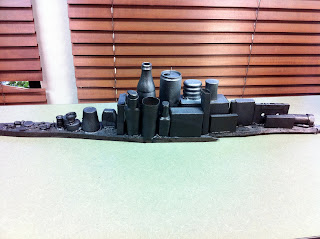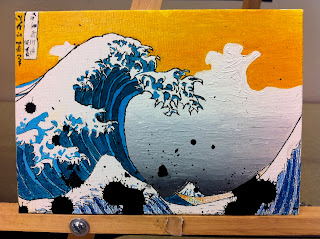One of my favorite TV shows is Parks and Recreation, a half-hour comedy starring Amy Poehler that follows the misadventures and accomplishments of a rag-tag group of government workers in the fictional town of Pawnee, Indiana. Last night I rewatched episode 9 from season 2 - "The Camel". The various Pawnee municipal departments are challenged to come up with concepts for a mural. Tom Haverford, played brilliantly by Aziz Ansari, is an underachieving administrator with entrepreneurial dreams, and he states rather bluntly that his has little interest in "non-nude art." As such, rather than creating something for the mural competition, he goes to a local art school and hires an artist:
Tom: Just give me $20 worth of art. Just something that seems personal that only I could have done.
Arnold: Tell me about yourself.
Tom: No. Just paint.
Upon receiving the painting, Tom does little to hide his distaste:
Tom: Dude, what the hell kind of art is this? It looks like a lizard puking up Skittles.
Arnold: I'm an abstract expressionist.
Tom: No, you're a con artist, and I'm a guy who's out 20 bucks. Ugh, whatever.
This is a reaction I sooooooooooo frequently hear in my classes when I teach about abstraction. I have a really open classroom dynamic and encourage conversation, and as such, I often get an earful about student's opinions, especially when I start showing works by Kandinsky, Picasso, Pollock and Rothko. I teach at a media arts college, and as such, my students are often tasked with creating visual imagery that is identifiable and purposeful. It has been easy for me to chalk up their frustration with abstract art as being a byproduct of their training in other classes, however it is undeniable that there is a widespread tendency toward criticism of and frustration with abstract artwork - you know...the "my five year old niece could do that" syndrome.
I am continually surprised by how hostile people can be toward abstraction. As a child, abstract art was my favorite. It seemed so free and often featured such bright colors, and best of all, I didn't need to know anything to be able to appreciate it. Unlike portraits of famous people who I didn't know and scenes of foreign landscapes, abstract splatters of color and shape were something with which I had a certain familiarity. Although my artistic taste has developed, I've always had an innate connection with abstract works.
As a teacher, it's difficult to know how to respond to attacks on abstraction. I've tried placing it within historical context, praising its avant-garde nature, however I often resort to broadly proclaiming "It doesn't matter that you, arguably, could do this....the fact is that Pollack did it first, and that's why it's so important!"
In the Parks & Rec episode, Tom faced similar hostility toward his proposed abstract mural design. In response Tom, still fairly indifferent to the work, took a look at the work and tried to sell the concept to the rest of the department.
Tom: It's abstract, Leslie. Over here you've got some shapes. And then, you come over to this side. You know it's actually kind of interesting. Each shape is its own thing, but then when it comes together, it really gives you a sense of, completion. Hmm.
I really recommend watching this episode (it's free on Netflix instant watch if you are a member), because Ansari acts out this part phenomenally. It's clear to see that his attitude shifts from indifference to curiosity to appreciation within just a few seconds of dwelling on the piece. Oh, I wish I could get all my students to that moment - not with every work, obviously...but if I could just find a way to help each student discover one piece that helps expand their idea of beauty and that could draw them in to developing an appreciation for abstraction I would be such a happy camper!
So, how can I do that? I think next time I teach about abstraction I might make copies of a bunch of different abstract pieces and have them each choose one to dwell on a bit. Perhaps by seeing a wide range of abstraction, they'll find a particular style they appreciate. However, a major problem with this is that as paintings move away from representational style, it seems that a greater emphasis is on the materiality of the piece - the luster of particular paints, layers of impasto, lighting effects, etc. Dang it, when are they going to invent teleporters so I can take my students on proper field trips?
How do you approach abstraction when you teach about modern art? Any tips you'd like to share?
I'll leave you with one last bit from Tom's experience with abstract art:
Tom: It’s beautiful. I’ve looked at this for five hours now. I like the green one. And the red circle right here. I’m tearing up, man.

















